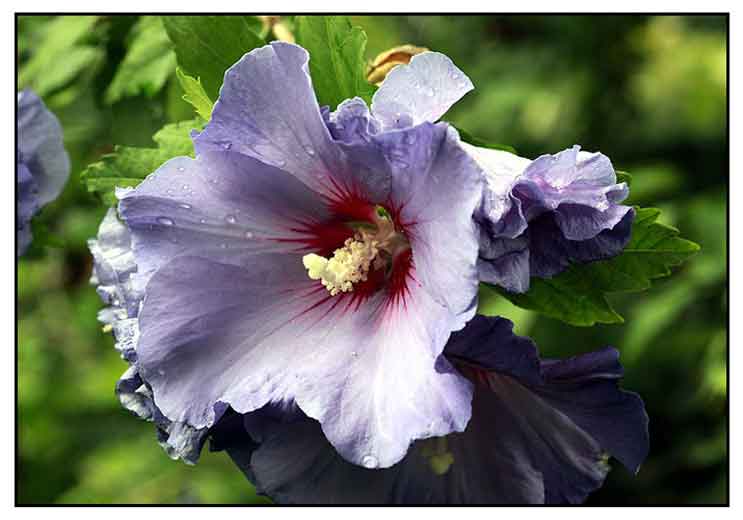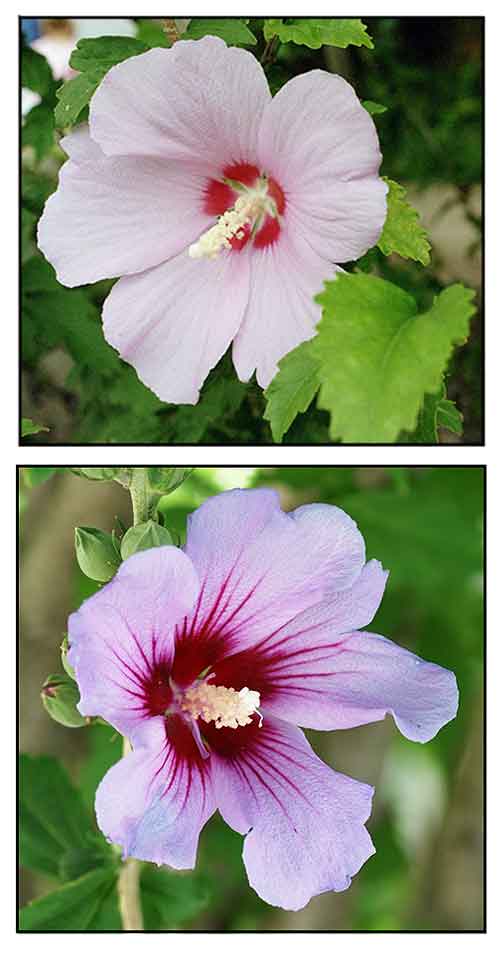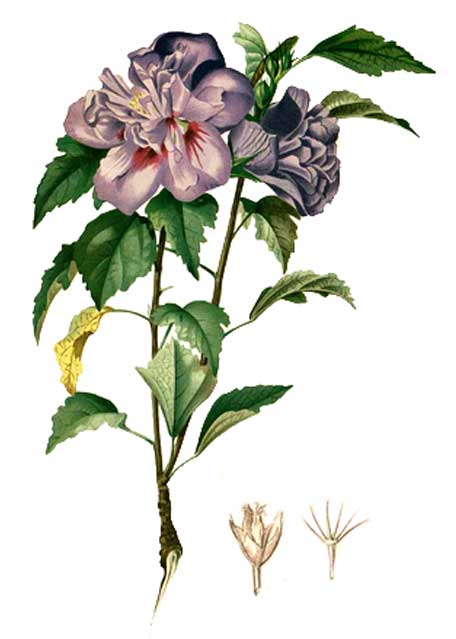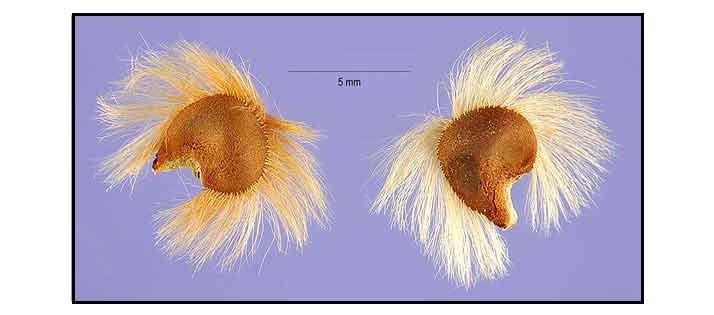|
 Gen info Gen info
- Hibiscus syriacus is a species of flowering plant in the mallow family, Malvaceae.
- Etymology: The genus name Hibiscus is the old Greek and Latin name for mallow. The epithet syriacus derives from the gardens in Syria where it has been collected.
-
Hibiscus syriacus is the national flower of South Korea. The flower appears in various national emblems. The flower's Korean name, mugunghwa or mokkeunhwa, translates to "eternal blossom that never fades". Korea is compared poetically to the flower in the Korean national anthem. The flower was considered a symbol of resistance to Japanese colonial rule. (20)
- Various cultivars have gained the Royal Horticultural Society's Award of Garden Merit.
- Note: The Philippine name Gumamelang asul (Blue gumamela) probably derives from Quisumbing's description of the flowers as "pale bluish-violet". However, flowers of the species vary in color: solid colors of white, red, purple, mauve, violet, or blue, or bicolors depending on the cultivar.
 Botany Botany
• Gumamelang-asul is a smooth and erect shrub growing to a height of 2 meters. Leaves are cuneiform-ovate, about 5 cm long, nearly or quite smooth, 3-lobed with toothed margins. Flowers are pale bluish-violet that do not open fully. Petals are obovate petals. Capsules are oblong, slightly hairy. Seeds are also hairy.
• Hibiscus syriacus is a hardy deciduous shrub. It is upright and vase-shaped, reaching 2–4 m (7–13 feet) in height, bearing large trumpet-shaped flowers with prominent yellow-tipped white stamens. Flowers are often pink in color, but can also be dark pink (almost purple), light pink or white. Individual flowers are short-lived, lasting only a day. However, numerous buds produced on the shrub's new growth provide prolific flowering over a long summer blooming period. The soil in which the Hibiscus thrives on is moist but well-drained, and organically rich. It is highly tolerant of air pollution, heat, humidity, poor soil and drought. The species has naturalized very well in many suburban areas and might even be termed slightly invasive, so frequently does it seed. Branches are thin and gray, white-lenticeled, with raised leaf scars and small buds. Stems and branches do not branch very much unless pruned, resulting in many long, straight stems that originate from about 1.5–4 cm (0.5–1.5 inches) above the ground, giving rise to the shrub's overall vase shape. Leaves are usually green or yellowish green, alternate, broadly ovate, palmately veined, and 7.5 cm (3 inches) long, with three distinct lobes with coarsely-toothed margins. Flowers are 5-petaled flowers (to 7.5 cm or 3 inches diameter) in solid colors of white, red, purple, mauve, violet, or blue, or bicolors with a different colored throat, depending upon the cultivar. Extending from the base of these five petals is the pistil at the center, with the stamen around it. These basic characteristics give the H. syriacus flower and its many variants their distinctive form. The plant can bloom continuously from July through September, usually at night. With maturity, flexible plant stems become weighted under the load of prolific summer flowers, and bend over halfway to the ground. Most modern cultivars are virtually fruitless. The fruits of those that have them are green or brown, unornamental 5-valved dehiscent capsules, which persist throughout much of the winter on older cultivars. They split over the course of the dormant season and spread their easily germinating seeds around the base of the parent plant, thus forming colonies with time. (20)
Distribution
- Ornamental cultivation.
- Naturalized.
- Native to China South-Central, China Southeast, Taiwan. (19)
- Now widely cultivated.
 Constituents Constituents
• Bark contains mucilage, carotenoids, sesquiterpenes, anthocyanidins.
• Study of bark yielded seven constituents: nonanedioic acid (1), suberic acid (2), 1-octarcosanol (3), β-sitosterol (4),1,22docosanediol (5), betulin (6) and erythrotriol (7). (12)
• Methanolic formic acid extraction of the petals of Hibiscus syriacus yielded 3-0-malonylglucosides of delphinidin, cyanidin, petunidin, pelargonidin, peonidin and malvidin. (14)
• Nutrient analysis of flowers showed comparable nutrients to common vegetables, with higher content of trace elements zinc and selenium (11.04 µg/100 g). (15)
• Study of leaves yielded 15 compounds viz., β-sitosterol(1), β-daucostero (2), β-amyrin (3), oleanolic acid (4), stigmast-4-en-3-one (5), friedelin (6), syriacusin A (7), kaempferol (8), isovitexin (9), vitexin (10), apigenin (11), apigenin-7-O-β-D-glucopyranoside (12), luteolin-7-O-β-D-glucopyranoside (13), vitexin-7-O-β-D-glucopyranoside (14) and rutin (15).
(see study below)
(16)
• Study of root bark yielded 4 new triterpenoids viz., 3β- acetoxy-olean-11-en,28,13β-olide (1), 3β- acetoxy-11α,12α-epoxy-olean-28,13β-olide (2), 19α-epi-betulin (3), and 20, 28-epoxy-17β,19β-lupan-3β-ol (4) together with 12 known compounds. (see study below) (17)
• Study of evaluated the nutritional and biochemical composition of each plant unit of H. syriacus 'Wonwha': petals, leaves, roots, and sprouts from seeds. The sprouts yielded highest content of amino and fatty acids adhering to requirements as nutritionally excellent food ingredients. Petals yielded high amounts of glucose, sucrose, and fumaric acid, with highest antioxidant activity. Bioactive compounds in the four units were o‐coumaric acid, p‐coumaric acid, schaftoside, isoschaftoside, apigenin‐6‐C‐glucoside‐7‐o‐glucoside, and kaempferol‐3‐O‐galactoside‐7‐O‐rhamnoside. Petals yielded the highest number of bioactive compounds: 2 phenolics and 22 flavonoids. (21)
• Phytochemical screening of methanol extract of
leaves yielded carbohydrates, glycosides, proteins, flavonoids, and tannins, with absence of steroids and alkaloids. (see study below) Water extract yileded carbohydrates, glycosides, flavonoids, tannins, and alkaloids, with absence of steroids and proteins. (see study below) (26)
Properties
• Considered anthelmintic, antiphlogistic, antipruritic, demulcent, diuretic, emollient, expectorant, febrifuge,stomachic and styptic.
• Bark and roots are mucilaginous.
• Studies have shown antioxidant, antiproliferative, MAO inhibitory, antifungal, antibacterial, apoptotic, wound healing, anti-neuroinflammatory, cytotoxic, sleep inducing, melanogenesis inhibitory,
α-glucosidase inhibitory, immune enhancing properties.
Parts
used
Flowers, bark and roots.
 Uses Uses
Edibility
• Flowers, leaves, root and oil are edible.
• Flowers impart a taste of lettuce.
• Flowers used for making tea.
• Tea made from flowers and leaves.
• Young leaves, eaten raw or cooked. Used as salad ingredient.
• Root is edible, though fibrous, and lacking flavor.
• In early Korea records, the leaves were brewed into a herbal infusion and the flowers eaten. (20)
Folkloric
• In Malaya, infusion of dried flowers used as a diuretic. Also used for itches and other skin ailments.
• Decoction of flowers used for dizziness, bloody stools.
• Leaves are used as stomachic.
• In Indo-China, used for dysentery.
• Bark and roots are mucilaginous; used as demulcent, for diarrhea, dysentery and dysmenorrhea.
• Seeds used for headaches and colds: also used in combination with pig marrow as an application to discharging ulcers.
• Flowers sometimes used as substitute for tea.
• Roots used for treatment of athlete's foot.
Others
• Fiber: Stems yield a fiber, used for making paper and rope.
• Shampoo: Hair shampoo made from the leaves.
• Dye: Blue dye obtained from the flowers.
Studies
• Antioxidant: Study on the stems and roots of Hibiscus syriacus showed the extract of heat-treated HS was more effective than those of non-treated HS in reducing the stable free radical DPPH. (2)
• Antiproliferative / Apoptosis by Activation of p53 and AIF in Human Lung Cancer cells: Study showed the acetone extract of HS exhibited better cytotoxic effect on lung cancer cells than the methanol and water extract. Results show HS-AE suppresses exerts significant dose-dependent anti-proliferative effect on cancer cells in vitro and in vivo. (3)
• Naphthalenes / Cytotoxicity / Anti-Lipid Peroxidation: Study isolated three naphthalenes from the root bark of Hibiscus syriacus – syriacusins A, B and C. The compounds exhibited lipid peroxidation and one showed cytotoxicity against some human cancer cell lines. (4)
• Anthocyanidin Malonylglucosides: Methanolic formic acid extract of petals yielded 3-O-malonylglucosides of delphinidin, cyanidin, pentunidin, pelargonidin, peonidin and malvidin. (6)
• Triterpene Esters / Lipid Peroxidation Inhibition / Anticancer: Root bark yielded two triterpene caffeates. Both compounds exhibited lipid peroxidation inhibitory activity and significant cytotoxicity against a panel of human cancer lines. (7)
• Coumarins / MAO Inhibitory Activity: Root bark yielded a coumarin, a new coumarin lignan, and known compounds scopoletin and cleomisconsins A, C, and D, The coumarin analogue and scopoletin inhibited MAO, while the coumarin lignan and cleomiscosin C exhibited lipid peroxidation inhibitory activity comparable to vitamin E. (8)
• Nonanoic Acid / Mutant H. syriacus / Antifungal Activity: Study of a methanolic extract of roots of H. syriacus Ggoma, produced by mutation breeding. The extract exhibited four time higher antifungal activity than its parent type against Trichophyton mentagrophytes. Spectroscopic analysis identified the antifungal substance as nonanoic acid. (10)
• Antioxidant / Leaves: Study evaluated a methanolic extract and fractions of leaves for antioxidant activity in invitro and ex vivo models. Results showed the CMF of leaves to scavenge superoxide radical, nitric oxide radical, reducing power and inhibited lipid peroxidation. The antioxidant activity can be attributed to phenolic compounds such as delphinidin, petunidin, malvidin, and quercetin. (11)
• Triterpenoids / Apoptosis / Anti-Breast Cancer: Screening of H. syriacus extracts identified a novel anti-cancer drug for patients with ER-negative breast cancer. The natural compound betulin (K02) and its derivatives (K03, K04, and K06) induced human breast cancer cell apoptosis and inhibited cell proliferation. Results suggest H. syriacus extracts might inhibit breast cancer cell viability and induce apoptosis by activating p53 family regulated pathways and inhibiting AKT activation. (13)
• α-Glucosidase Inhibitory Activity / Leaves: Study evaluated H. syriascus for chemical constituents and α-glucosidase inhibitory activities. Fifteen compounds were isolated from the leaves. Compounds 7 and 9—syriacusin and isovitexin, showed strong α-glucosidase inhibitory activities with IC50 of 39.03 ± 0.38 and 32.12 ± 0.62 mg/L, inhibition ration of 94.95% and 97.15%. (see constituents above) (16)
• Cytotoxic Effect of Triterpenoids / Root Bark: Study of root bark yielded 4 new triterpenoids together with 12 known compounds. Extract and the compounds were evaluated for cytotoxicity against A549 human lung cancer cells. Compound 12, betulin-3-caffeate, significantly reduced cell viability (IC50 4.3 µM. (see constituents above) (17)
• Saponarin / Effect on Sleep Disorders / Flowers: Study evaluated the effect of extract of H. syriacus flower (HSF) as an alternative treatment for sleep disorders. Study confirmed the desirable effects of HSF extract and its active constituent, saponarin, on anxiolysis and Wake times. HSF increased REM sleep time. HSF and saponarin restored sleep rate and sleep bout duration, and increased sleep maintenance time. Results suggest HSF extract and saponarin are effective in maintaining sleep and may be used as a novel treatment for sleep disorder in humans. (22)
• Skin-Protective / Anti-Inflammatory / Flowers: A comparative study evaluated the skin protective effect of mugunghwa flowers, cortexes, roots, leaves and seeds in external factor-stimulated human epidermal keratinocytes (HaCaTs), normal human dermal fibroblasts (NHDFs), and a murine macrophage cell line (RAW 264.7 cells). HPLC identified palmitic acid and linoleic acid as active components. Results showed that among all five parts of the plant, the flowers effectively inhibited lipopolysaccharide, ultraviolet B irradiation, and scratching wound-induced inflammation in skin cells. (23)
• Skin Wound Healing and Hydration / Leaves: Study evaluated the healing and hydration properties of H. syriacus ethanolic extract of leaves (HSEE). The HSEE treatment increased the healing potential of fibroblasts and keratinocytes. The HSEE significantly stimulated fibronectin and collagen synthesis by 16 and 60%, respectively, while fibroblasts contractility was enhanced by 30%. On skin implants, the HSEE accelerated wound healing in terms of epithelium formation and fibronectin production, and increased expression of genes involved in skin hydration and homeostasis. Aquaporin 3 and filaggrin genes were enhanced by 20 and 58%, respectively. Study shows HSEE contain compounds capable of stimulating expression of biomarkers relevant to skin regeneration and hydration, counteracting molecular pathways leading to skin damage and aging. (24)
• Inhibition of Neuro-Inflammation in LPS-Treated SH-SY5Y Cell / Polyphenols / Flowers: Study of ethanol extract of flowers isolated five polyphenols (1-5) and five fatty acids (6-10). Compounds 1-5 exhibited neuroprotective effect in LPS or H2O2-treated SH-Sy5Y cell. By PVR analysis, the compounds could effectively improve mRNA expression of synapse-related gene and neurotrophic factors (Syp, NGF, and BDNF) in LPS-treated SH-Sy5Y cell. Compounds 1-5 also inhibited neuroinflammation (TNF-α, IL-1ß and IL-6) in LPS-treated SH-Sy5Y cell. Results suggest the polyphenols have potential for the prevention of neuroinflammation. (25)
• Antibacterial / Leaves: Study evaluated the antimicrobial activity of different crude extracts of H. syriacus against four bacterial pathogens i.e., Bacillus cereus, Staphylococcus epidermis, Klebsiella pneumonia, and Bacillus subtilis by well diffusion method. Methanol extracts showed maximum zone of inhibition (19.1, 19.6, 22.9 and 25.4 mm, respectively, against the tested pathogens. Klebsiella spp was the most resistant strain. Results suggest antibacterial activity and a potential new source for a novel antibacterial. (26)
• Ultrasonic-Assisted Extraction / Anti-Inflammatory / Pro-Apoptotic: Study evaluated the anti-inflammatory effects of H. syriacus extract (HSE) in LPS-stimulated raw 264.7 cells. Ultrasonic extraction showed to be the most effective for reduction of free radical species by DPPH assay. The HSE decreased PGE2 concentration and COX-2 activity and reduced the expression of COX-2 and IL-6 in LPS stimulated Raw 264.7 cells. HSE inhibited the proliferation and induced apoptosis with increase expression of pro-apoptotic proteins such as caspase-3, -7, -9, Bax, Bim, FOXO3, and p53 in LPS-stimulated Raw 264.7 cells. Results suggest potential for treatment of inflammation via regulation of pro-inflammatory COX-2, IL-6, and PGE2 and induction of apoptosis. (27)
• Anthocyanins / Inhibition of Melanogenesis via ERK Signaling Pathway: Study evaluated whether anthocyanins from H. syriacus varieties Pulsae and Paektanshim (PS and PTYS) inhibit melanin biogenesis. B16F10 cells and zebrafish larvae were exposed to PS and PTS in the presence of absence of α-melanocyte-stimulating hormone (α-MSH) and melanin contents. PS and PTS moderately down-regulated mushroom tyrosinase activity in vitro, and significantly decreased extracellular and intracellular melanin production in B16F10 cells, and inhibited α-MSH-induced expression of MITF and tyrosinase. Chromatography data showed PS and PTS possessed 17 identical anthocyanins as a negative regulator of ERK. Results suggest anthocyanins from PS and PTs inhibited melanogenesis in vitro and in vivo by activating the ERK signaling pathway. (28)
• Immune-Enhancing / Roots: Study evaluated the immune activation activities of root extracts of Hibiscus syriacus (HSR) and its potential mechanism in macrophages. HSR dose-dependently increased the production of immunomodulators such as nitric oxide (NO), inducible nitric oxide synthase (iNOS), cyclooxygenase-2 (COX-2), interleukin-1ß (IL-1ß), and tumor necrosis factor (TNF-α) activated phagocytosis in macrophages. Inhibition of toll-like receptors 4 (TLR4) reduced production of immuno-modulators induced by HSR. Inhibition of MAPKs, NF-kB, and PI3K signaling attenuated the production of immunomodulators induced by HSR. Results suggest HSR has the potential for enhancing immunity. (29)
Availability
- Wild-crafted.
- Cultivated.
- Hibiscus syriacus flower tea. |



 Botany
Botany Constituents
Constituents Uses
Uses

